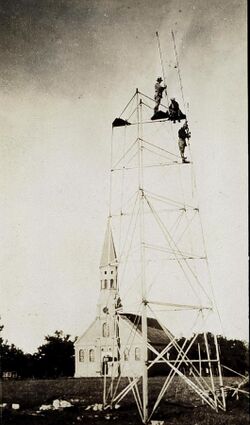Engineering:Bilby tower
A Bilby tower is a type of steel survey tower used by the United States Coast and Geodetic Survey from 1927 to 1984.[1] It is named after Jasper S. Bilby who designed it in 1926.[2] In 1927, Herbert Hoover, then the Secretary of Commerce, commended Bilby's tower "for its cost and time efficiency" and cited the surveyor's service as "essential to the United States government".[3]
History
Jasper Sherman Bilby (July 16, 1864 - July 18, 1949) was a surveyor in the United States Coast and Geodetic Survey (USC&GS) from 1884 to 1937. He served as Chief Signalman of the USC&GS from 1930 to 1937. Bilby was born on July 16, 1864, in Rush County, Indiana.[4] He had a tumultuous upbringing, with his father committing suicide in prison in 1877 after being accused of a sexual assault.[4][5] This forced Bilby to drop out of school and work on the family farm to support his family. He joined the United States Coast and Geodetic Survey in 1884 as a surveyor to help map the coasts of the United States.[4]
Design of the Bilby Tower
Bilby began designing the first version of the Bilby tower in 1926 and worked with the Aermotor Windmill Company to develop the first prototypes. The tower was designed to elevate surveyors high enough to look over obstructions and to account for the curvature of the Earth in their calculations.[6][7] The tower was tested with positive results and Bilby received a commendation from Secretary of Commerce Herbert Hoover for the invention.[6]
The Bilby Tower was a massive success, saving money compared to previous options and increasing the efficiency of the USC&GS surveyors. They could be constructed and deconstructed in less than a third of the time of previous towers, were lighter, and were easier to move.[8] In 1928 alone, use of the Bilby Tower cut costs by up to 35%, and over its first ten years of use it saved the government an estimated $3,000,000 (equivalent to $44,155,172 in 2019).[6][9] Its use also spread outside the United States, reaching as far as Australia and Denmark .[6] The towers were credited by The New York Times as being "one of the greatest aids to geodetic work."[10]
Legacy
In 1930, Bilby was promoted to the newly created position of "Chief Signalman" of the USC&GS.[6][11] In 1932 the federal retirement age was waived to allow him to continue serving. He retired in 1937.[6] Over the course of his 53-year career, Bilby traveled over 500,000 miles across the United States.[4] Bilby died on July 18, 1949, in Batesville, Indiana.[6] The last remaining tower, at St. Charles Parish, Louisiana, was dismantled by the Surveyors Historical Society in 2012 and re-erected in 2013 at the Osgood Trails Park in Osgood, Indiana, the home town of Bilby.[12]
Features
The Bilby tower has two unconnected parts – an internal tower for mounting surveying instruments and an external tower for surveyors. This separation allowed for isolating the instruments from the vibrations induced by people, which increased the precision of measurements. It was portable, reusable and quick to assemble and dismantle. Its quick erection made it possible to conduct surveying rapidly.[13]
See also
References
- ↑ Administration, US Department of Commerce, National Oceanic and Atmospheric. "Survey Towers: Bilby Tower" (in EN-US). https://celebrating200years.noaa.gov/survey_towers/bilby.html.
- ↑ Administration, US Department of Commerce, National Oceanic and Atmospheric. "Bilby Towers" (in EN-US). https://celebrating200years.noaa.gov/magazine/bilby/welcome.html.
- ↑ "Bilby Steel Tower" (in en-US). http://www.in.gov/history/markers/4326.htm.
- ↑ 4.0 4.1 4.2 4.3 Clark, Justin (2016-03-10). "Jasper Sherman Bilby: To Map the Earth, Part I". https://blog.history.in.gov/jasper-sherman-bilby-to-map-the-earth-part-one/.
- ↑ "The Daily News Items". Indianapolis News: pp. 2. 1877-04-17. https://newspapers.library.in.gov/cgi-bin/indiana?a=d&d=INN18770417-01.1.2&srpos=18&e=-------en-20--1--txt-txIN-Jasper+Bilby------.
- ↑ 6.0 6.1 6.2 6.3 6.4 6.5 6.6 Clark, Justin (2016-03-14). "Jasper Sherman Bilby: To Map the Earth, Part II". Indiana Historical Bureau. https://blog.history.in.gov/jasper-sherman-bilby-to-map-the-earth-part-ii/.
- ↑ Wilford, John Noble (2000). The Mapmakers (Revised ed.). New York: Alfred A. Knopf. pp. 357–359. ISBN 0-375-40929-7. https://archive.org/details/mapmakers00wilf_0/page/n8/mode/1up?q=bilby.
- ↑ Ervin, Adrienne (1927). "Bilby Tower for Government Surveys". The Military Engineer 19 (107): 400–401.
- ↑ Annual Report of the Director, United States Coast and Geodetic Survey to the Secretary of Commerce for the Fiscal Year Ended June 30, 1928. Washington, D.C.: Government Printing Office. 1928. pp. 24. https://docs.lib.noaa.gov/rescue/cgs/005_pdf/CSC-0132.PDF.
- ↑ Durham, John (1930-09-21). "Nation's Vast Geodetic Survey to Give New Accuracy in Maps". The New York Times: pp. X14. ProQuest 98916316.
- ↑ Smith, Gretchen S. (1930-05-16). "J.S. Bilby Is Urged To Continue Work". The Evening Star: pp. 24. https://www.newspapers.com/article/evening-star-js-bilby-is-urged-to-cont/124860448/.
- ↑ "Bilby Tower Dedication Honoring Jasper Sherman Bilby - xyHt" (in en-US). xyHt. 2014-08-21. http://www.xyht.com/surveying/bilby-tower-dedication-honoring-jasper-sherman-bilby/.
- ↑ Administration, US Department of Commerce, National Oceanic and Atmospheric. "Historic Traveling Bilby Tower 'Comes Home' to Osgood, Indiana" (in EN-US). http://oceanservice.noaa.gov/news/features/nov13/last-bilby-tower.html.
 |



